-
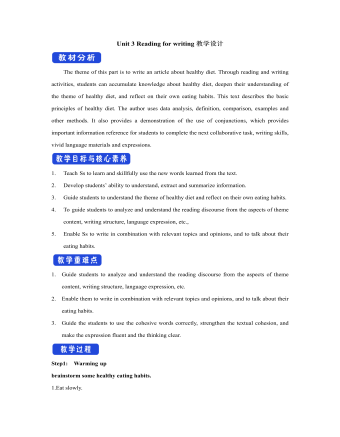
新人教版高中英语选修2Unit 3 Reading for writing教学设计
The theme of this part is to write an article about healthy diet. Through reading and writing activities, students can accumulate knowledge about healthy diet, deepen their understanding of the theme of healthy diet, and reflect on their own eating habits. This text describes the basic principles of healthy diet. The author uses data analysis, definition, comparison, examples and other methods. It also provides a demonstration of the use of conjunctions, which provides important information reference for students to complete the next collaborative task, writing skills, vivid language materials and expressions.1. Teach Ss to learn and skillfully use the new words learned from the text.2. Develop students’ ability to understand, extract and summarize information.3. Guide students to understand the theme of healthy diet and reflect on their own eating habits.4. To guide students to analyze and understand the reading discourse from the aspects of theme content, writing structure, language expression, etc., 5. Enable Ss to write in combination with relevant topics and opinions, and to talk about their eating habits.1. Guide students to analyze and understand the reading discourse from the aspects of theme content, writing structure, language expression, etc.2. Enable them to write in combination with relevant topics and opinions, and to talk about their eating habits.3. Guide the students to use the cohesive words correctly, strengthen the textual cohesion, and make the expression fluent and the thinking clear.Step1: Warming upbrainstorm some healthy eating habits.1.Eat slowly.2.Don’t eat too much fat or sugar.3.Eat healthy food.4.Have a balanced diet.Step2: Read the passage and then sum up the main idea of each paragraph.
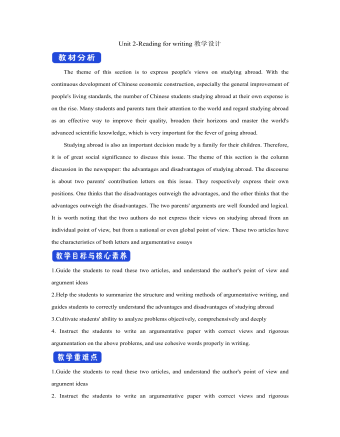
新人教版高中英语选修2Unit 2 Reading for writing教学设计
The theme of this section is to express people's views on studying abroad. With the continuous development of Chinese economic construction, especially the general improvement of people's living standards, the number of Chinese students studying abroad at their own expense is on the rise. Many students and parents turn their attention to the world and regard studying abroad as an effective way to improve their quality, broaden their horizons and master the world's advanced scientific knowledge, which is very important for the fever of going abroad. Studying abroad is also an important decision made by a family for their children. Therefore, it is of great social significance to discuss this issue. The theme of this section is the column discussion in the newspaper: the advantages and disadvantages of studying abroad. The discourse is about two parents' contribution letters on this issue. They respectively express their own positions. One thinks that the disadvantages outweigh the advantages, and the other thinks that the advantages outweigh the disadvantages. The two parents' arguments are well founded and logical. It is worth noting that the two authors do not express their views on studying abroad from an individual point of view, but from a national or even global point of view. These two articles have the characteristics of both letters and argumentative essays1.Guide the students to read these two articles, and understand the author's point of view and argument ideas2.Help the students to summarize the structure and writing methods of argumentative writing, and guides students to correctly understand the advantages and disadvantages of studying abroad3.Cultivate students' ability to analyze problems objectively, comprehensively and deeply
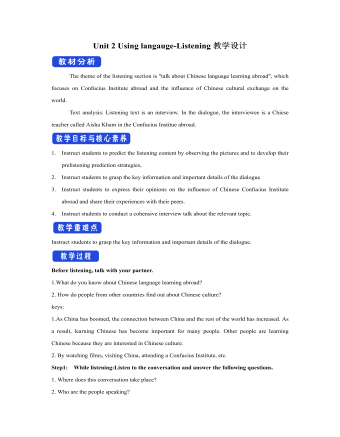
新人教版高中英语选修2Unit 2 Using langauge-Listening教学设计
? B: Absolutely! Getting involved with Chinese cultural activities there definitely helped a lot. I got to practice my Chinese on a daily basis, and I could learn how native Chinese speakers spoke.? A: What do you feel is your biggest achievement?? B: Learning Chinese characters! I have learnt about 1,500 so far. When I first started, I didn't think it was even going to be possible to learn so many, but now I find that I can read signs, menus, and even some easy newspaper articles.? A: What are you most keen on?? B: I've really become keen on learning more about the Chinese culture, in particular Chinese calligraphy. As I have learnt Chinese characters, I have developed a great appreciation for their meaning. I want to explore Chinese characters by learning how to write them in a more beautiful way. ? A: Finally, what do you want to say to anyone interested in learning Chinese?? I have really become keen on learning more about the Chinese culture, in particular Chinese Calligraphy. As I have learnt Chinese character, I have developed a great appreciation for their meaning. I want to explore Chinese characters by learning how to write them in a more beautiful way.? A: Finally, what do you want to say to anyone interested in learning Chinese?? B: I'd say, give it a shot! While some aspects may be difficult, it is quite rewarding and you will be happy that you tried.? A: Thanks for your time. ? B:You're welcome.
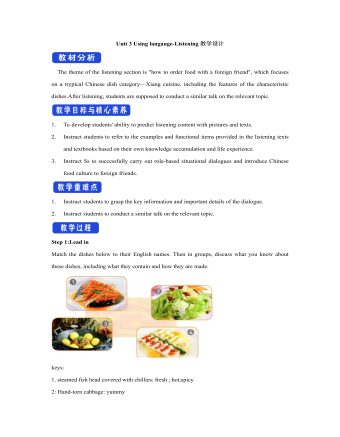
新人教版高中英语选修2Unit 3 Using langauge-Listening教学设计
1. How is Hunan cuisine somewhat different from Sichuan cuisine?The heat in Sichuan cuisine comes from chilies and Sichuan peppercorns. Human cuisine is often hotter and the heat comes from just chilies.2.What are the reasons why Hunan people like spicy food?Because they are a bold people. But many Chinese people think that hot food helps them overcome the effects of rainy or wet weather.3.Why do so many people love steamed fish head covered with chilies?People love it because the meat is quite tender and there are very few small bones.4.Why does Tingting recommend bridge tofu instead of dry pot duck with golden buns?Because bridge tofu has a lighter taste.5 .Why is red braised pork the most famous dish?Because Chairman Mao was from Hunan, and this was his favorite food.Step 5: Instruct students to make a short presentation to the class about your choice. Use the example and useful phrases below to help them.? In groups of three, discuss what types of restaurant you would like to take a foreign visitor to, and why. Then take turns role-playing taking your foreign guest to the restaurant you have chosen. One of you should act as the foreign guest, one as the Chinese host, and one as the waiter or waitress. You may start like this:? EXAMPLE? A: I really love spicy food, so what dish would you recommend?? B: I suggest Mapo tofu.? A: Really ? what's that?
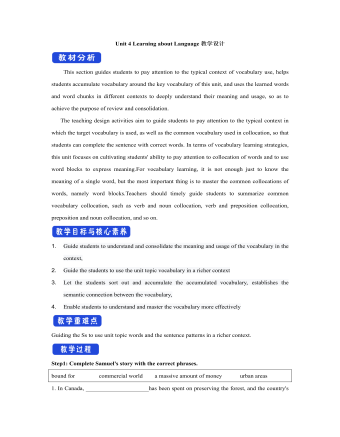
新人教版高中英语选修2Unit 4 Learning about Language教学设计
This section guides students to pay attention to the typical context of vocabulary use, helps students accumulate vocabulary around the key vocabulary of this unit, and uses the learned words and word chunks in different contexts to deeply understand their meaning and usage, so as to achieve the purpose of review and consolidation.The teaching design activities aim to guide students to pay attention to the typical context in which the target vocabulary is used, as well as the common vocabulary used in collocation, so that students can complete the sentence with correct words. In terms of vocabulary learning strategies, this unit focuses on cultivating students' ability to pay attention to collocation of words and to use word blocks to express meaning.For vocabulary learning, it is not enough just to know the meaning of a single word, but the most important thing is to master the common collocations of words, namely word blocks.Teachers should timely guide students to summarize common vocabulary collocation, such as verb and noun collocation, verb and preposition collocation, preposition and noun collocation, and so on.1. Guide students to understand and consolidate the meaning and usage of the vocabulary in the context, 2. Guide the students to use the unit topic vocabulary in a richer context3. Let the students sort out and accumulate the accumulated vocabulary, establishes the semantic connection between the vocabulary,4. Enable students to understand and master the vocabulary more effectivelyGuiding the Ss to use unit topic words and the sentence patterns in a richer context.
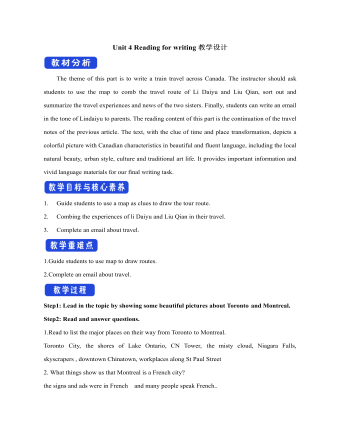
新人教版高中英语选修2Unit 4 Reading for writing教学设计
假定你是英国的Jack,打算来中国旅行,请你给你的中国笔友李华写一封信,要点如下:1.你的旅行计划:北京→泰山→杭州;2.征求建议并询问他是否愿意充当你的导游。注意:1.词数80左右(开头和结尾已给出,不计入总词数);2.可以适当增加细节,以使行文连贯。参考词汇:故宫 the Forbidden City;泰山 Mount TaiDear Li Hua,I'm glad to tell you that 'm going to visit China.First,I am planning to visit Beijing,the capitalof China,where I am looking forward to enjoying the Great Wall,the Forbidden City and somebeautiful parks.Then I intend to go to visit Mount Tai in Shandong Province.I've heard that it is one ofthe most famous mountains in China and I can't wait to enjoy the amazing sunrise there.After that,I amalso going to Hangzhou.It is said that it is a beautiful modern city with breathtaking natural sights,among which the West Lake is a well- known tourist attraction.What do you think of my travel plan? Will you act as my guide? Hope to hear from you soon.
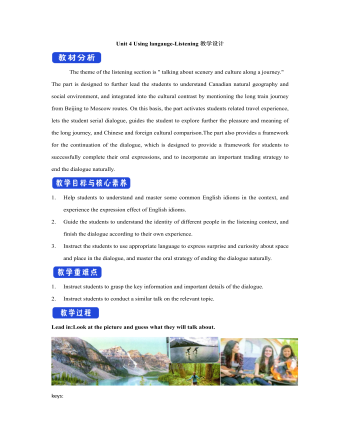
新人教版高中英语选修2Unit 4 Using langauge-Listening教学设计
The theme of the listening section is " talking about scenery and culture along a journey."The part is designed to further lead the students to understand Canadian natural geography and social environment, and integrated into the cultural contrast by mentioning the long train journey from Beijing to Moscow routes. On this basis, the part activates students related travel experience, lets the student serial dialogue, guides the student to explore further the pleasure and meaning of the long journey, and Chinese and foreign cultural comparison.The part also provides a framework for the continuation of the dialogue, which is designed to provide a framework for students to successfully complete their oral expressions, and to incorporate an important trading strategy to end the dialogue naturally.1. Help students to understand and master some common English idioms in the context, and experience the expression effect of English idioms.2. Guide the students to understand the identity of different people in the listening context, and finish the dialogue according to their own experience.3. Instruct the students to use appropriate language to express surprise and curiosity about space and place in the dialogue, and master the oral strategy of ending the dialogue naturally.1. Instruct students to grasp the key information and important details of the dialogue.2. Instruct students to conduct a similar talk on the relevant topic.
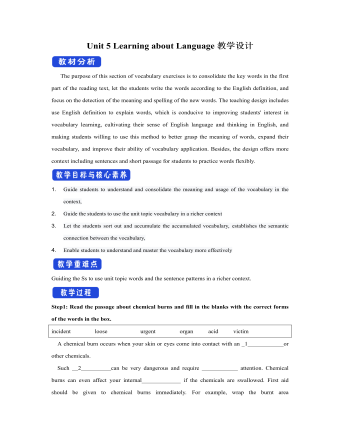
新人教版高中英语选修2Unit 5 Learning about Language教学设计
The purpose of this section of vocabulary exercises is to consolidate the key words in the first part of the reading text, let the students write the words according to the English definition, and focus on the detection of the meaning and spelling of the new words. The teaching design includes use English definition to explain words, which is conducive to improving students' interest in vocabulary learning, cultivating their sense of English language and thinking in English, and making students willing to use this method to better grasp the meaning of words, expand their vocabulary, and improve their ability of vocabulary application. Besides, the design offers more context including sentences and short passage for students to practice words flexibly.1. Guide students to understand and consolidate the meaning and usage of the vocabulary in the context, 2. Guide the students to use the unit topic vocabulary in a richer context3. Let the students sort out and accumulate the accumulated vocabulary, establishes the semantic connection between the vocabulary,4. Enable students to understand and master the vocabulary more effectivelyGuiding the Ss to use unit topic words and the sentence patterns in a richer context.Step1: Read the passage about chemical burns and fill in the blanks with the correct forms of the words in the box.
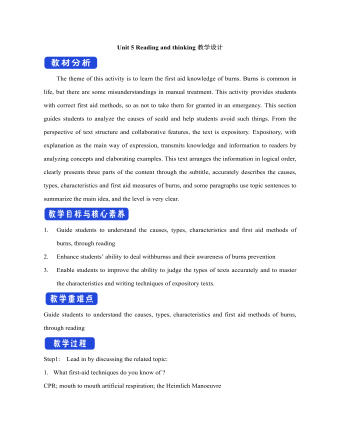
新人教版高中英语选修2Unit 5 Reading and thinking教学设计
The theme of this activity is to learn the first aid knowledge of burns. Burns is common in life, but there are some misunderstandings in manual treatment. This activity provides students with correct first aid methods, so as not to take them for granted in an emergency. This section guides students to analyze the causes of scald and help students avoid such things. From the perspective of text structure and collaborative features, the text is expository. Expository, with explanation as the main way of expression, transmits knowledge and information to readers by analyzing concepts and elaborating examples. This text arranges the information in logical order, clearly presents three parts of the content through the subtitle, accurately describes the causes, types, characteristics and first aid measures of burns, and some paragraphs use topic sentences to summarize the main idea, and the level is very clear.1. Guide students to understand the causes, types, characteristics and first aid methods of burns, through reading2. Enhance students’ ability to deal withburnss and their awareness of burns prevention3. Enable students to improve the ability to judge the types of texts accurately and to master the characteristics and writing techniques of expository texts.Guide students to understand the causes, types, characteristics and first aid methods of burns, through readingStep1: Lead in by discussing the related topic:1. What first-aid techniques do you know of ?CPR; mouth to mouth artificial respiration; the Heimlich Manoeuvre
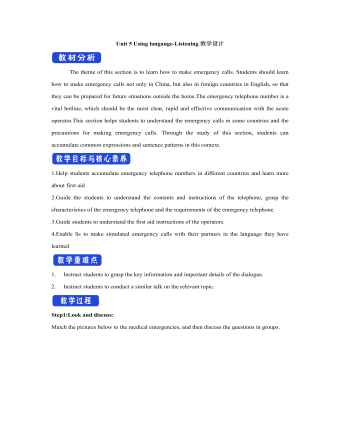
新人教版高中英语选修2Unit 5 Using langauge-Listening教学设计
The theme of this section is to learn how to make emergency calls. Students should learn how to make emergency calls not only in China, but also in foreign countries in English, so that they can be prepared for future situations outside the home.The emergency telephone number is a vital hotline, which should be the most clear, rapid and effective communication with the acute operator.This section helps students to understand the emergency calls in some countries and the precautions for making emergency calls. Through the study of this section, students can accumulate common expressions and sentence patterns in this context. 1.Help students accumulate emergency telephone numbers in different countries and learn more about first aid2.Guide the students to understand the contents and instructions of the telephone, grasp the characteristics of the emergency telephone and the requirements of the emergency telephone.3.Guide students to understand the first aid instructions of the operators.4.Enable Ss to make simulated emergency calls with their partners in the language they have learned1. Instruct students to grasp the key information and important details of the dialogue.2. Instruct students to conduct a similar talk on the relevant topic.Step1:Look and discuss:Match the pictures below to the medical emergencies, and then discuss the questions in groups.
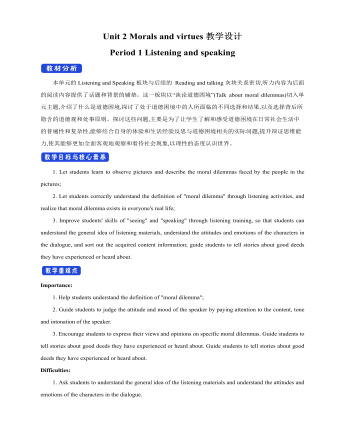
新人教版高中英语必修3Unit 2 Morals and virtues教学设计一
(2) students are divided into groups according to the requirements of activity 3. Each student shares a story of personal experience or hearing-witnessing kindness, and then selects the most touching story in the group and shares it with the whole class. Before the students share the story, the teacher can instruct them to use the words and sentence patterns in the box to express. For example, the words in the box can be classified:Time order: first of all, then, after that, later, finally logical relationship :so, however, although, butTeachers can also appropriately add some transitional language to enrich students' expression:Afterwards, afterwards, at last, in the end, eventuallySpatial order: next to, far from, on the left, in front ofOtherwise, nevertheless, as a result, therefore, furthermore, in addition, as well asSummary: in a word, in short, on the whole, to sum up, in briefStep 8 Homework1. Understand the definition of "moral dilemma" and establish a correct moral view;2. Accumulate vocabulary about attitudes and emotions in listening texts and use them to express your own views;3. Complete relevant exercises in the guide plan.1、通过本节内容学习,学生能否理解理解“道德困境”的定义;2、通过本节内容学习,学生能否通过说话人所表达的内容、说话的语气、语调等来判断其态度和情绪;3、通过本节内容学习,学生能否针对具体的道德困境发表自己的看法和见解,能否掌握听力理训练中的听力策略。
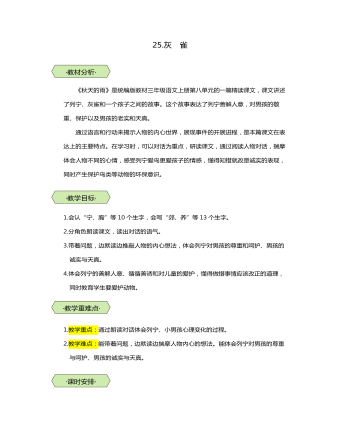
统编版三年级语文上第25课灰雀教学设计教案
《秋天的雨》是统编版教材三年级语文上册第八单元的一篇精读课文,课文讲述了列宁、灰雀和一个孩子之间的故事。这个故事表达了列宁善解人意,对男孩的敬重、保护以及男孩的老实和天真。通过语言和行动来揭示人物的内心世界,展现事件的开展进程,是本篇课文在表达上的主要特点。在学习时,可以对话为重点,研读课文,通过阅读人物对话,揣摩体会人物不同的心情,感受列宁爱鸟更爱孩子的情感,懂得知错就改是诚实的表现,同时产生保护鸟类等动物的环保意识。 1.会认“宁、胸”等10个生字,会写“郊、养”等13个生字。2.分角色朗读课文,读出对话的语气。3.带着问题,边默读边推敲人物的内心想法,体会列宁对男孩的尊重和呵护、男孩的诚实与天真。4.体会列宁的善解人意、循循善诱和对儿童的爱护,懂得做错事情应该改正的道理,同时教育学生要爱护动物。 1.教学重点:通过朗读对话体会列宁、小男孩心理变化的过程。2.教学难点:能带着问题,边默读边揣摩人物内心的想法。能体会列宁对男孩的尊重与呵护、男孩的诚实与天真。 2课时
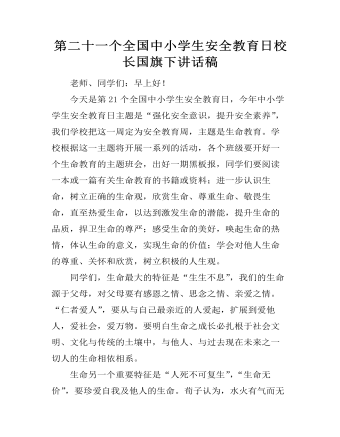
第二十一个全国中小学生安全教育日校长国旗下讲话稿
老师、同学们:早上好!今天是第21个全国中小学生安全教育日,今年中小学学生安全教育日主题是“强化安全意识,提升安全素养”,我们学校把这一周定为安全教育周,主题是生命教育。学校根据这一主题将开展一系列的活动,各个班级要开好一个生命教育的主题班会,出好一期黑板报,同学们要阅读一本或一篇有关生命教育的书籍或资料;进一步认识生命,树立正确的生命观,欣赏生命、尊重生命、敬畏生命,直至热爱生命,以达到激发生命的潜能,提升生命的品质,捍卫生命的尊严;感受生命的美好,唤起生命的热情,体认生命的意义,实现生命的价值;学会对他人生命的尊重、关怀和欣赏,树立积极的人生观。同学们,生命最大的特征是“生生不息”,我们的生命源于父母,对父母要有感恩之情、思念之情、亲爱之情。“仁者爱人”,要从与自己最亲近的人爱起,扩展到爱他人,爱社会,爱万物。要明白生命之成长必扎根于社会文明、文化与传统的土壤中,与他人、与过去现在未来之一切人的生命相依相系。
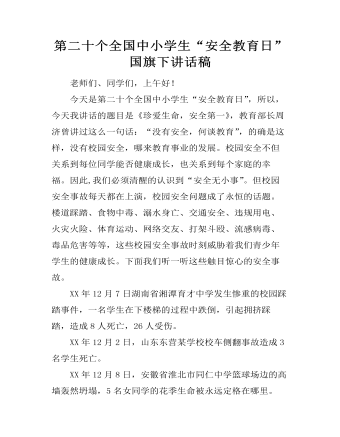
第二十个全国中小学生“安全教育日”国旗下讲话稿
老师们、同学们,上午好!今天是第二十个全国中小学生“安全教育日”,所以,今天我讲话的题目是《珍爱生命,安全第一》,教育部长周济曾讲过这么一句话:“没有安全,何谈教育”,的确是这样,没有校园安全,哪来教育事业的发展。校园安全不但关系到每位同学能否健康成长,也关系到每个家庭的幸福。因此,我们必须清醒的认识到“安全无小事”。但校园安全事故每天都在上演,校园安全问题成了永恒的话题。楼道踩踏、食物中毒、溺水身亡、交通安全、违规用电、火灾火险、体育运动、网络交友、打架斗殴、流感病毒、毒品危害等等,这些校园安全事故时刻威胁着我们青少年学生的健康成长。下面我们听一听这些触目惊心的安全事故。XX年12月7日湖南省湘潭育才中学发生惨重的校园踩踏事件,一名学生在下楼梯的过程中跌倒,引起拥挤踩踏,造成8人死亡,26人受伤。XX年12月2日,山东东营某学校校车侧翻事故造成3名学生死亡。XX年12月8日,安徽省淮北市同仁中学篮球场边的高墙轰然坍塌,5名女同学的花季生命被永远定格在哪里。XX年4月27日,辽宁省葫芦岛市某中学6名学生校外私自游泳,溺水死亡。
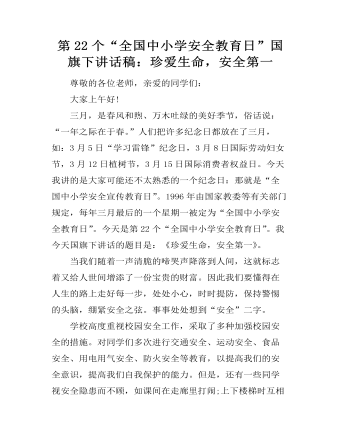
第22个“全国中小学安全教育日”国旗下讲话稿:珍爱生命,安全第一
尊敬的各位老师,亲爱的同学们:大家上午好!三月,是春风和煦、万木吐绿的美好季节,俗话说:“一年之际在于春。”人们把许多纪念日都放在了三月,如:3月5日“学习雷锋”纪念日,3月8日国际劳动妇女节,3月12日植树节,3月15日国际消费者权益日。今天我讲的是大家可能还不太熟悉的一个纪念日:那就是“全国中小学安全宣传教育日”。1996年由国家教委等有关部门规定,每年三月最后的一个星期一被定为“全国中小学安全教育日”。今天是第22个“全国中小学安全教育日”。我今天国旗下讲话的题目是:《珍爱生命,安全第一》。当我们随着一声清脆的啼哭声降落到人间,这就标志着又给人世间增添了一份宝贵的财富。因此我们要懂得在人生的路上走好每一步,处处小心,时时提防,保持警惕的头脑,绷紧安全之弦。事事处处想到“安全”二字。学校高度重视校园安全工作,采取了多种加强校园安全的措施。对同学们多次进行交通安全、运动安全、食品安全、用电用气安全、防火安全等教育,以提高我们的安全意识,提高我们自我保护的能力。但是,还有一些同学视安全隐患而不顾,如课间在走廊里打闹;上下楼梯时互相拥挤
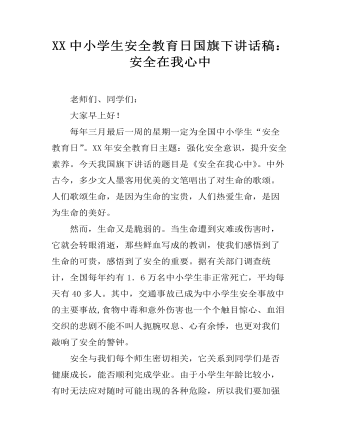
XX中小学生安全教育日国旗下讲话稿:安全在我心中
老师们、同学们:大家早上好!每年三月最后一周的星期一定为全国中小学生“安全教育日”。XX年安全教育日主题:强化安全意识,提升安全素养。今天我国旗下讲话的题目是《安全在我心中》。中外古今,多少文人墨客用优美的文笔唱出了对生命的歌颂。人们歌颂生命,是因为生命的宝贵,人们热爱生命,是因为生命的美好。然而,生命又是脆弱的。当生命遭到灾难或伤害时,它就会转眼消逝,那些鲜血写成的教训,使我们感悟到了生命的可贵,感悟到了安全的重要。据有关部门调查统计,全国每年约有1.6万名中小学生非正常死亡,平均每天有40多人。其中,交通事故已成为中小学生安全事故中的主要事故,食物中毒和意外伤害也一个个触目惊心、血泪交织的悲剧不能不叫人扼腕叹息、心有余悸,也更对我们敲响了安全的警钟。安全与我们每个师生密切相关,它关系到同学们是否健康成长,能否顺利完成学业。由于小学生年龄比较小,有时无法应对随时可能出现的各种危险,所以我们要加强教育,让学生远离危险,认识生活中的各种安全问题,学会正确处置意外,做好防范、树立起自我保护意识,提高自我保护的能力。
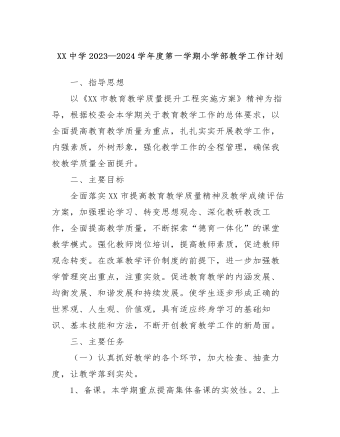
XX中学2023—2024学年度第一学期小学部教学工作计划
8、加强对音、体、美、等课程实施的监督与检查,确保上足课节。9、将学困生转化工作及优生培养工作落到实处。提高对学困生的关注度,加强对学困生的心理辅导及课业辅导。10、每周一次级部长会,每月一次学科长会,建立教务会议记录,学科教研、活动记录,教师上交材料记录。11、本学期共21周,实际授课17周。五、教学工作配档表九月1、划分班级,安排好教师课务,排好课程表。2、参加XX市教研室召开的小学教学教研工作会议3、安排各科教师参加XX市教研室组织的学科研讨。4、制定好各种教学、教研工作计划。5、安排并开展本学期公开课活动。6、印发各种表册。7、对小一新生建档。8、做好十一长假的作业布置工作十月1、组织学习烟台市小学教学常规、课程标准的学习。2、检查集体备课情况。3、进行书法、口算、口语表达技能比赛。4、积极准备上级的专项教学常规督导。5、积极打磨XX市学科优质课。
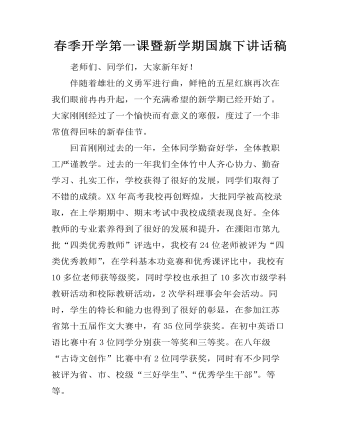
春季开学第一课暨新学期国旗下讲话稿
老师们、同学们,大家新年好!伴随着雄壮的义勇军进行曲,鲜艳的五星红旗再次在我们眼前冉冉升起,一个充满希望的新学期已经开始了。大家刚刚经过了一个愉快而有意义的寒假,度过了一个非常值得回味的新春佳节。回首刚刚过去的一年,全体同学勤奋好学,全体教职工严谨教学。过去的一年我们全体竹中人齐心协力、勤奋学习、扎实工作,学校获得了很好的发展,同学们取得了不错的成绩。XX年高考我校再创辉煌,大批同学被高校录取,在上学期期中、期末考试中我校成绩表现良好。全体教师的专业素养得到了很好的发展和提升,在溧阳市第九批“四类优秀教师”评选中,我校有24位老师被评为“四类优秀教师”,在学科基本功竞赛和优秀课评比中,我校有10多位老师获等级奖,同时学校也承担了10多次市级学科教研活动和校际教研活动,2次学科理事会年会活动。同时,学生的特长和能力也得到了很好的彰显,在参加江苏省第十五届作文大赛中,有35位同学获奖。在初中英语口语比赛中有3位同学分别获一等奖和三等奖。在八年级“古诗文创作”比赛中有2位同学获奖,同时有不少同学被评为省、市、校级“三好学生”、“优秀学生干部”。等等。
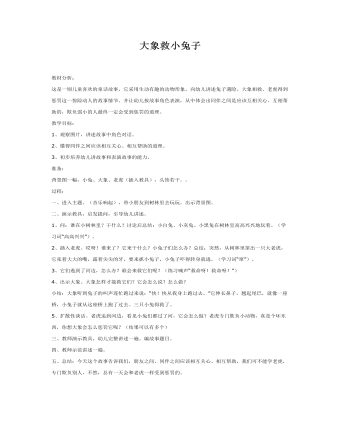
中班语言课件教案:大象救小兔子
教学目标: 1、观察图片,讲述故事中角色对话。 2、懂得同伴之间应该相互关心、相互帮助的道理。 3、初步培养幼儿讲故事和表演故事的能力。 准备: 背景图一幅,小兔、大象、老虎(插入教具),头饰若干。。 过程: 一、进入主题。(音乐响起),带小朋友到树林里去玩玩。出示背景图。 二、演示教具,启发提问,引导幼儿讲述。 1、问:谁在小树林里?干什么?讨论后总结:小白兔、小灰兔、小黑兔在树林里高高兴兴地玩着。(学习词“高高兴兴”)。 2、插入老虎。哎呀!谁来了?它来干什么?小兔子们怎么办?总结:突然,从树林里窜出一只大老虎,它张着大大的嘴,露着尖尖的牙,要来抓小兔子,小兔子吓得转身就逃。(学习词“窜”)。
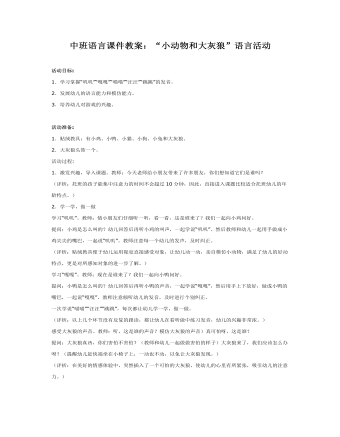
中班语言课件教案:“小动物和大灰狼”语言活动
2.发展幼儿的语言能力和模仿能力。3.培养幼儿对游戏的兴趣。 活动准备:1.贴绒教具:有小鸡、小鸭、小猫、小狗、小兔和大灰狼。2.大灰狼头饰一个。活动过程:1.激发兴趣,导入课题。教师:今天老师给小朋友带来了许多朋友,你们想知道它们是谁吗?(评析:托班的孩子能集中注意力的时间不会超过10分钟,因此,直接进入课题比较适合托班幼儿的年龄特点。)2.学一学,做一做学习“叽叽”。教师:情小朋友们仔细听一听,看一看,这是谁来了?我们一起向小鸡问好。提问:小鸡是怎么叫的?幼儿回答后再听小鸡的叫声,一起学说“叽叽”。然后教师和幼儿一起用手做成小鸡尖尖的嘴巴,一起说“叽叽”。教师注意每一个幼儿的发声,及时纠正。(评析:贴绒教具便于幼儿运用视觉直接感受对象,让幼儿动一动,亲自模仿小动物,满足了幼儿的好动特点,更是对所感知对象的进一步了解。)学习“嘎嘎”。教师:现在是谁来了?我们一起向小鸭问好。提问:小鸭是怎么叫的?幼儿回答后再听小鸭的声音,一起学说“嘎嘎”,然后用手上下放好,做成小鸭的嘴巴,一起说“嘎嘎”。教师注意倾听幼儿的发音,及时进行个别纠正。一次学说“喵喵”“汪汪”“跳跳”,每次都让幼儿学一学,做一做。(评析:以上几个环节没有反复的跟读,都让幼儿在看听做中练习发音,幼儿的兴趣非常浓。)感受大灰狼的声音。教师:听,这是谁的声音?模仿大灰狼的声音)真可怕呀,这是谁?


